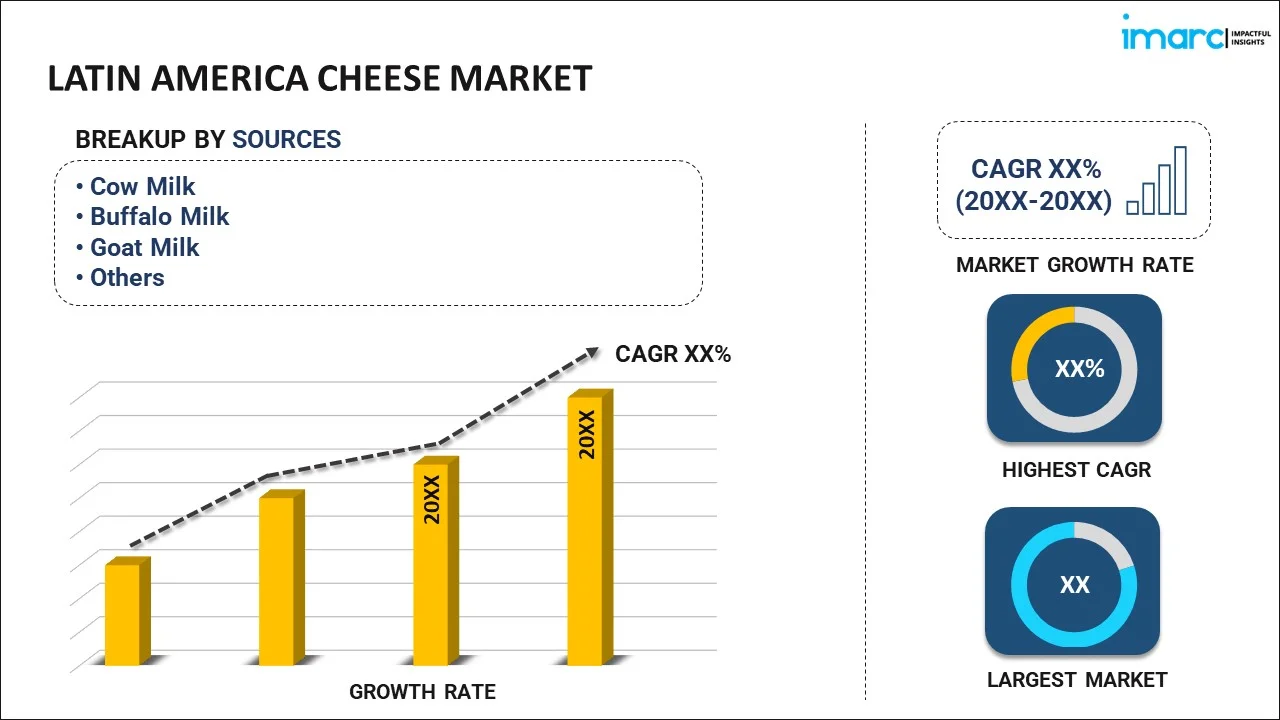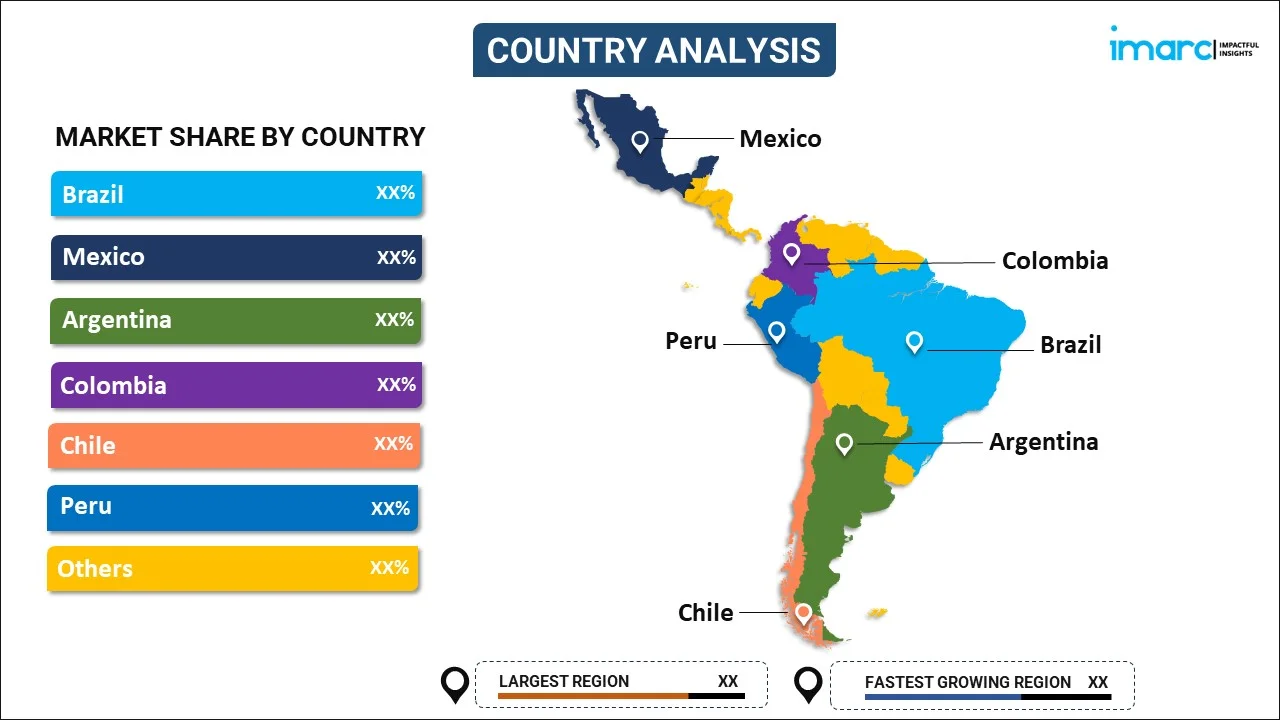
Latin America Cheese Market Report by Source (Cow Milk, Buffalo Milk, Goat Milk, and Others), Type (Natural, Processed), Product (Mozzarella, Cheddar, Feta, Parmesan, Roquefort, and Others), Distribution Channel (Supermarkets and Hypermarkets, Convenience Stores, Specialty Stores, Online, and Others), Format (Slices, Diced/Cubes, Shredded, Blocks, Spreads, Liquid, and Others), and Country 2025-2033
Latin America Cheese Market Overview:
The Latin America cheese market size reached 1.70 Million Tons in 2024. Looking forward, IMARC Group expects the market to reach 2.03 Million Tons by 2033, exhibiting a growth rate (CAGR) of 1.93% during 2025-2033. Latin America offers different types of cheese, including cream cheese, mozzarella, burrata, and macaroni cheese, each offering unique textures and flavors. The region’s major producers are driving market growth with increased demand for milk, cultures, enzymes, and additives. Shifting dietary preferences, especially in urban areas, is boosting cheese consumption. The cow's milk segment, particularly natural and cheddar cheeses, leads due to its versatility, availability, and established production methods.
|
Report Attribute
|
Key Statistics
|
|---|---|
|
Base Year
|
2024
|
|
Forecast Years
|
2025-2033
|
|
Historical Years
|
2019-2024
|
|
Market Size in 2024
|
1.70 Million Tons |
|
Market Forecast in 2033
|
2.03 Million Tons |
| Market Growth Rate 2025-2033 | 1.93% |
Latin America Cheese Market Trends:
Rising Demand for Plant-Based Cheese
The increasing popularity of plant-based diets and growing worries about animal health and well-being are key drivers of demand for plant-based cheese in Latin America. With more consumers shifting to vegan or plant-based lifestyles, the market for cheese has witnessed a significant shift towards dairy-free products. Vegan cheese, often produced from coconut, nuts, or soy, provides a cruelty-free alternative with the same texture and taste as dairy cheese. Latin America, and Brazil and Argentina in particular, has welcomed this phenomenon, with domestic companies and foreign chains responding to the increasing demand for such products. As a reaction to consumer demand, plant-based cheese manufacturers continuously enhance the quality of their products to better delight consumers through improved taste, texture, and nutritional content. Increased interest in veganism in the region, fueled by worldwide dietary patterns, has resulted in an upsurge in plant-based cheese items that are attractive to both vegan consumers and individuals looking for healthier options. Furthermore, the growth of sustainable production methods and attention to reducing the environmental footprint of dairy production has further increased the demand for plant-based cheese. Growing further, Latin American nations are likely to witness more innovation and growth in this segment, hence rendering plant-based cheese one of the main drivers of the region's cheese market, including varieties like Mexican cheese.
Emergence of Artisanal Cheese and Local Manufacturing
The growing demand for artisanal products in Latin America has created a boom in the production and consumption of locally made, handcrafted cheeses. Artisanal cheese is usually made through time-honored processes, emphasizing quality, distinct flavors, and limited quantity production. This phenomenon has picked up pace among customers looking for authentic, high-quality food experiences that are linked to local culture and heritage. Latin America, with its rich food heritage, has witnessed the development of artisanal cheese as an emerging niche in the larger cheese market. In nations like Mexico, Brazil, and Argentina, local artisanal cheesemakers are becoming popular for the finer flavor of their products, which is frequently due to the utilization of native ingredients and traditional methods. These cheeses, such as regional ones like Mexico's Queso Cotija or Brazil's Queijo Minas, carry a unique flavor profile that differentiates them from industrially produced counterparts. Demand for artisan cheese is also being driven by growing numbers of foodies and restaurants seeking out distinctive, locally produced ingredients. This movement towards artisan production has spurred small-scale producers to commit to sustainable processes, further appealing to consumer demand for ethically sourced products, driving market expansion in Latin America. The appeal of American cheese and Italian cheese has also fueled the desire for diverse flavors and quality cheeses across the region.
Key Market Segmentation:
IMARC Group provides an analysis of the key trends in each sub-segment of the Latin America cheese market report, along with forecasts at the regional and country level from 2025-2033. Our report has categorized the market based on source, type, product, distribution channel and format.
Breakup by Source:

- Cow Milk
- Buffalo Milk
- Goat Milk
- Others
Breakup by Type:
- Natural
- Processed
Breakup by Product:
- Mozzarella
- Cheddar
- Feta
- Parmesan
- Roquefort
- Others
Breakup by Distribution Channel:
- Supermarkets and Hypermarkets
- Convenience Stores
- Specialty Stores
- Online
- Others
Breakup by Format:
- Slices
- Diced/Cubes
- Shredded
- Blocks
- Spreads
- Liquid
- Others
Breakup by Country:

- Brazil
- Mexico
- Argentina
- Colombia
- Chile
- Peru
- Others
Brazil is the market leader in the Latin American cheese market, thanks mainly to its huge consumer base and increasing demand for cheese. The huge dairy output of the country, particularly from cow milk, renders it the primary producer of processed as well as natural cheese products, including mozzarella, cheddar, and local styles such as Queijo Minas. Urbanization, increased disposable incomes, and shifting consumer needs have all contributed significantly towards growing Brazil's cheese market. In addition, the growing middle class and increasing desire for both domestic and foreign cheese products drive demand for a vast array of offerings, including dairy-free alternatives. Brazil's established dairy infrastructure, from production to delivery, makes it a continued leader and results in the further expansion of the market.
Competitive Landscape:
The competitive landscape of the industry has also been examined along with the profiles of the key players.
Latin America Cheese Market Recent News:
- December 2024: Gayo Azul expanded its Hispanic cheese line with the launch of Queso Fresco, adding to its popular Cotija, Queso Blanco, and Queso Para Freir varieties. This move capitalized on the growing demand for Hispanic cheeses, boosting market growth and catering to evolving consumer preferences.
- September 2024: RELCO partnered with Milky Mist Dairy to launch India’s largest Cheddar cheese plant. This new facility, featuring advanced cheese production technology, will double milk processing capacity and enhance export potential. The project is set to impact the global cheese market by increasing production efficiency.
Report Coverage:
| Report Features | Details |
|---|---|
| Base Year of the Analysis | 2024 |
| Historical Period | 2019-2024 |
| Forecast Period | 2025-2033 |
| Units | Million Tons |
| Segment Coverage | Source, Type, Product, Distribution Channel, Format, Country |
| Countries Covered | Brazil, Mexico, Argentina, Colombia, Chile, Peru, Others |
| Customization Scope | 10% Free Customization |
| Post-Sale Analyst Support | 10-12 Weeks |
| Delivery Format | PDF and Excel through Email (We can also provide the editable version of the report in PPT/Word format on special request) |
Key Questions Answered in This Report
The Latin America cheese market is expected to grow at a CAGR of 1.93% during 2025-2033.
The Latin America cheese market is driven by growing demand for diverse cheese varieties, evolving consumer preferences for healthier options, and increased urbanization. Additionally, rising disposable incomes and changing dietary habits, including an interest in international cuisines, are further boosting market growth.
COVID-19 drove up household cheese purchases in Latin America as people cooked food at home. Soft and fresh cheeses gained popularity, but restaurant closures and tighter incomes hit overall market growth. Supermarket sales stayed strong since cheese became an affordable, flexible option.
Based on the source, the Latin America cheese market has been segmented into cow milk, buffalo milk, goat milk, and others.
Based on the type, the Latin America cheese market has been segmented into natural and processed.
Based on the product, the Latin America cheese market has been segmented into mozzarella, cheddar, feta, parmesan, Roquefort, and others.
Based on the distribution channel, the Latin America cheese market has been segmented into supermarkets and hypermarkets, convenience stores, specialty stores, online, and others.
Based on the format, the Latin America cheese market has been segmented into slices, diced/cubes, shredded, blocks, spreads, liquid, and others.
On a regional level, the Latin America cheese market has been segmented into Brazil, Mexico, Argentina, Colombia, Chile, Peru, and others.
Need more help?
- Speak to our experienced analysts for insights on the current market scenarios.
- Include additional segments and countries to customize the report as per your requirement.
- Gain an unparalleled competitive advantage in your domain by understanding how to utilize the report and positively impacting your operations and revenue.
- For further assistance, please connect with our analysts.
 Request Customization
Request Customization
 Speak to an Analyst
Speak to an Analyst
 Request Brochure
Request Brochure
 Inquire Before Buying
Inquire Before Buying




.webp)




.webp)












